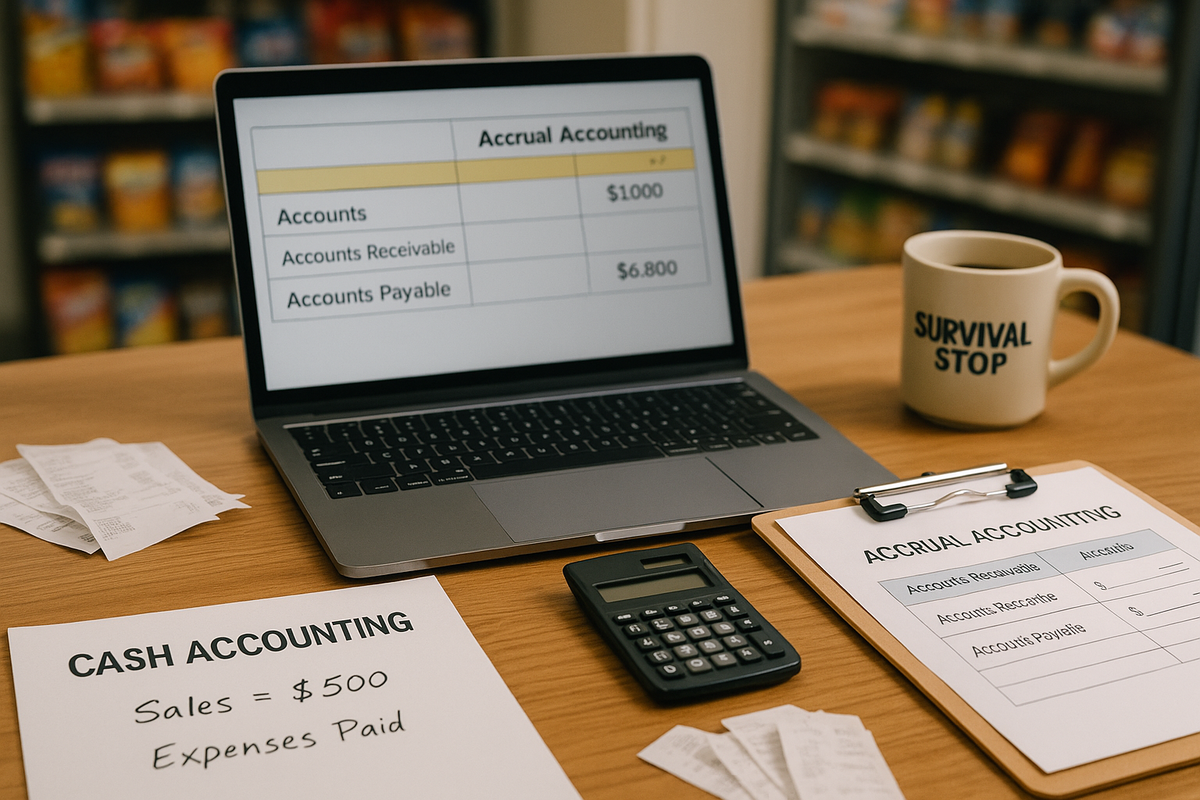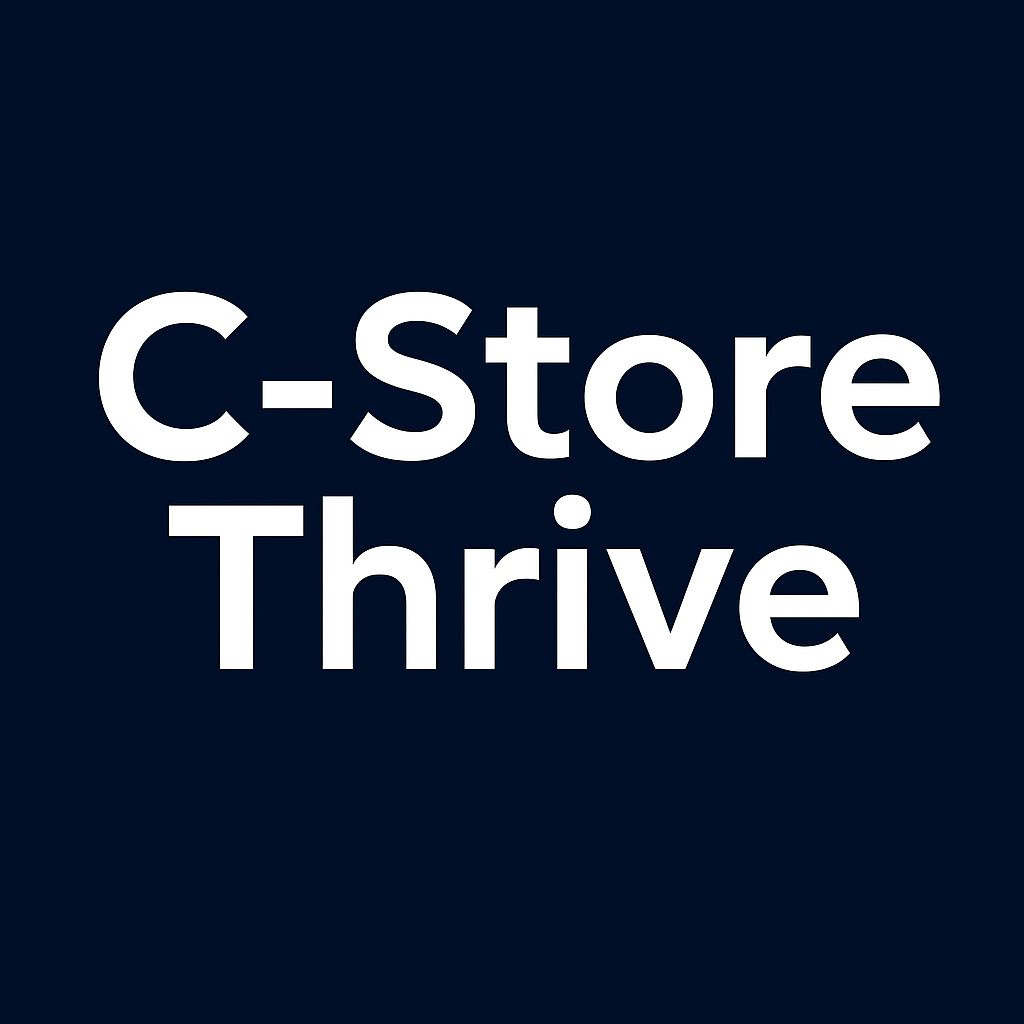Cash vs. Accrual Accounting: What's Right for Your Store?
Choosing between cash and accrual accounting impacts taxes, cash flow management, and business growth. Recent tax law changes raised the threshold to $25 million, allowing more C-store owners to choose cash accounting even with substantial inventory operations.

Choosing the right accounting method isn't just a bookkeeping decision—it's a strategic choice that impacts your taxes, cash flow management, and business growth. Here's how to determine which approach best serves your convenience store operation.
The decision between cash and accrual accounting represents one of the most consequential choices facing independent convenience store owners. Unlike other business decisions that can be easily reversed, your accounting method affects everything from daily cash flow visibility to annual tax obligations and long-term growth strategies. With the IRS allowing more flexibility for small businesses under recent tax reforms, C-store owners now have greater opportunity to optimize their accounting approach for maximum benefit.
The stakes are particularly high for convenience stores. Your business operates on razor-thin margins, processes over 1,100 transactions daily, and manages complex inventory across multiple product categories. The wrong accounting method can obscure critical financial insights, complicate tax planning, and hinder your ability to make informed decisions about inventory, pricing, and expansion.
Recent changes to federal tax law have raised the gross receipts threshold to $25 million (adjusted annually for inflation, currently $30 million for 2024), meaning more C-store owners can now choose cash accounting even with substantial inventory operations. However, this flexibility comes with important considerations that every store owner must understand before making the switch.
Understanding the Fundamental Difference
Cash Accounting: When Money Actually Moves
Cash accounting records transactions only when money changes hands. If you sell $500 worth of merchandise on Monday but don't deposit the cash until Tuesday, the sale gets recorded on Tuesday. Similarly, when you receive an invoice for $200 in supplies but don't pay it until next month, the expense is recorded when you actually write the check.
For C-store operations, this means:
- Daily sales are recorded when you make bank deposits
- Vendor payments are recorded when checks clear or cards are charged
- Lottery commissions are recorded when you receive payment from the state
- Credit card sales are recorded when funds hit your bank account (usually 1-2 days later)
Accrual Accounting: When Economic Events Occur
Accrual accounting records transactions when the economic event happens, regardless of cash timing. The $500 sale gets recorded on Monday when the customer leaves with the merchandise, even if you don't deposit the cash until Tuesday. The $200 supply expense gets recorded when you receive the invoice, even if you don't pay it for 30 days.
For C-store operations, this means:
- Sales are recorded when customers complete purchases, regardless of payment method timing
- Expenses are recorded when you receive goods or services, not when you pay for them
- End-of-month inventory adjustments reflect actual shrinkage and spoilage
- Financial statements show true profitability for specific time periods
The C-Store Perspective: Unique Considerations
High-Volume, Low-Margin Operations
Convenience stores typically process 400,000+ transactions annually with average transaction values of $8-12. This volume creates specific accounting challenges:
Cash Method Advantages:
- Immediate cash flow visibility: You always know exactly how much money you have available
- Simpler daily procedures: No need to track outstanding receivables or payables
- Tax timing flexibility: Can defer income or accelerate expenses near year-end for tax planning
Accrual Method Advantages:
- Better margin analysis: Revenue and related costs are matched in the same period
- Accurate performance measurement: Can compare sales performance across different time periods
- Professional reporting: Financial statements meet banking and investor requirements
Inventory Management Complexity
C-stores typically carry 3,000-5,000 SKUs across diverse categories from fuel to prepared foods. Each category has different margin structures and turnover rates:
Cash accounting challenges with inventory:
- Timing mismatches: Large inventory purchases can make profitable months appear unprofitable
- Seasonal distortions: Holiday inventory buildups can skew quarterly comparisons
- Shrinkage tracking: Difficult to identify theft or spoilage patterns when costs and sales aren't matched
Accrual accounting benefits for inventory:
- Matching principle: Cost of goods sold aligns with actual sales in each period
- Better shrinkage analysis: Can identify loss patterns by comparing expected vs. actual inventory
- Improved vendor negotiations: Clear visibility into category profitability supports pricing discussions
The $25 Million Rule: What It Means for Your Store
IRS Gross Receipts Test
Under current federal tax law, businesses with average annual gross receipts of $25 million or less (adjusted to $30 million for 2024) over the prior three years can choose cash accounting, even if they maintain inventory. This calculation uses a three-year average, so a single high-revenue year won't immediately disqualify you.
Example calculation:
- 2021: $8 million in gross receipts
- 2022: $9.5 million in gross receipts
- 2023: $11 million in gross receipts
- Three-year average: $9.5 million (well below the $30 million threshold)
What Counts as Gross Receipts
For C-stores, gross receipts include:
- All sales revenue from merchandise, fuel, food service, and other services
- Lottery commissions received from the state
- ATM commissions and other fee income
- Insurance reimbursements for business losses
What doesn't count:
- Sales tax collected (passed through to government)
- Customer deposits that will be refunded
- Loans received for business operations
Special Inventory Rules for Qualifying Businesses
If you meet the gross receipts test, you have two options for handling inventory:
Option 1: Non-Incidental Materials and Supplies (NIMS)
- Track inventory on your books but deduct costs only when items are sold
- Simpler than traditional accrual inventory accounting
- Still provides good management information for ordering decisions
Option 2: Follow Your Financial Statement Method
- Use whatever inventory method you use for your own business analysis
- Must be consistent and reasonable
- Can't conflict with other tax accounting requirements
Cash Accounting: Advantages for C-Stores
Simplified Daily Operations
Streamlined recordkeeping appeals to many store owners who want to focus on operations rather than complex accounting procedures:
- Daily sales equal bank deposits: Easy to reconcile and understand
- Expense tracking matches checkbook: Payments are recorded when made
- No accounts receivable: Customer transactions are completed immediately
- Clear cash position: Always know available funds for inventory purchases or emergencies
Tax Planning Flexibility
Cash accounting provides significant year-end tax planning opportunities:
Income deferral strategies:
- Delay December invoicing to push income into the following tax year
- Time lottery commission payments to optimize tax brackets
- Coordinate with accountant on major equipment purchases
Expense acceleration tactics:
- Prepay January expenses in December to increase current-year deductions
- Stock up on inventory before year-end (if using NIMS method)
- Accelerate equipment maintenance and repairs
Better Cash Flow Management
For businesses operating on tight margins and daily cash cycles, the cash method provides critical visibility:
- Real-time financial position: Never show profits you can't access
- Easier budgeting: Income and expenses align with actual cash availability
- Simplified banking relationships: Financial statements match bank account balances
Accrual Accounting: When It Makes Sense
Accurate Performance Measurement
Accrual accounting provides superior business intelligence for growth-oriented stores:
Monthly comparisons: Revenue and expenses are matched by time period, making it easy to identify trends and seasonal patterns
Category analysis: Can determine true profitability of different product lines by matching purchase costs with sales revenue
Operational insights: Identify the impact of promotions, price changes, or operational improvements on actual profitability
Professional Financial Reporting
If you're seeking financing, investors, or potential buyers, accrual statements are typically required:
- Bank lending: Most commercial loans require accrual-based financial statements
- SBA financing: Government-backed loans typically require GAAP-compliant reporting
- Business sales: Potential buyers expect accrual statements for valuation purposes
- Franchise requirements: Many franchise agreements specify accrual accounting
Better Business Decision Making
Accrual accounting supports more sophisticated business analysis:
Inventory management: Match purchase costs with sales to identify optimal stock levels and reorder points
Pricing strategies: Understand true margins by category to optimize pricing and promotional decisions
Vendor negotiations: Armed with accurate profitability data, negotiate better terms with suppliers
Expansion planning: Accurate financial performance data supports location analysis and growth decisions
Practical Implementation Considerations
Technology Requirements
Cash accounting technology needs:
- Basic POS system with daily sales reporting
- Simple accounting software (QuickBooks Simple Start level)
- Bank reconciliation capabilities
- Basic expense tracking
Accrual accounting technology needs:
- Integrated POS and accounting software
- Accounts payable management system
- Inventory management capabilities
- More sophisticated reporting tools
Staffing and Training
Cash method staffing:
- Can often be managed by store owner with basic bookkeeping knowledge
- Minimal staff training required
- Lower professional accounting costs
Accrual method staffing:
- May require dedicated bookkeeper or accounting professional
- Staff needs training on proper invoice processing
- Higher ongoing professional support costs
Seasonal Considerations
C-stores experience predictable seasonal patterns that accounting methods handle differently:
Summer season impact:
- Cash method: Large inventory purchases for summer items may make profitable months appear break-even
- Accrual method: Matches inventory costs with actual sales, providing clearer profitability picture
Holiday season considerations:
- Cash method: December inventory purchases reduce reported income, potentially lowering tax liability
- Accrual method: Shows true holiday season profitability for planning future years
Making the Switch: Practical Steps
From Cash to Accrual
Required IRS procedures:
- File Form 3115 (Application for Change in Accounting Method)
- Calculate Section 481(a) adjustment for the transition
- Work with tax professional to ensure compliance
Operational changes needed:
- Implement accounts payable tracking system
- Train staff on proper invoice processing
- Set up monthly financial statement preparation
- Establish inventory management procedures
From Accrual to Cash
Eligibility verification:
- Confirm you meet the $25 million gross receipts test
- Determine inventory method (NIMS vs. financial statement method)
- Plan for Section 481(a) adjustment impact
System modifications:
- Simplify daily accounting procedures
- Implement cash-basis reporting
- Train staff on new transaction recording methods
- Modify management reporting systems
Common Mistakes to Avoid
Cash Method Pitfalls
Ignoring inventory timing: Large purchases can distort monthly profitability analysis, making it difficult to identify operational improvements
Poor tax planning: Failing to work with accountant on year-end strategies misses significant tax saving opportunities
Inadequate management reporting: Focusing only on cash position while ignoring operational metrics like margins and turnover rates
Accrual Method Errors
Over-complicating systems: Implementing unnecessarily complex procedures that don't add value for management decision-making
Inconsistent application: Mixing cash and accrual concepts, which can invalidate financial statements and create tax compliance issues
Neglecting cash flow: Focusing on accrual profits while ignoring actual cash availability for operations
Industry-Specific Recommendations
Single-Location Independent Stores
Recommended approach: Cash method with NIMS inventory
- Provides operational simplicity with adequate management information
- Allows tax planning flexibility crucial for small business owners
- Reduces administrative burden and professional fees
Multi-Location Operations
Recommended approach: Accrual method
- Better supports consolidated financial reporting across locations
- Provides accurate performance comparisons between stores
- Meets lender and investor expectations for larger operations
High-Growth Stores
Consider accrual method even if cash-eligible
- Provides better data for expansion planning
- Positions business for eventual sale or financing needs
- Supports more sophisticated inventory and pricing strategies
The Bottom Line: Making Your Decision
Choose cash accounting if:
- Your primary concern is simplicity and tax planning
- You have limited accounting staff and want to minimize administrative burden
- Cash flow management is more critical than detailed performance analysis
- You're not seeking financing or planning to sell the business soon
Choose accrual accounting if:
- You need accurate performance measurement for business decision-making
- You're planning to seek financing or have investor relationships
- Inventory management and category profitability analysis are critical
- You have the staff and systems to handle more complex accounting requirements
Consider professional guidance regardless of your choice. The decision affects multiple aspects of your business, and the transition process has important tax implications that require expert navigation.
Conclusion
The choice between cash and accrual accounting isn't just about compliance—it's about aligning your financial systems with your business goals and operational realities. For many convenience store owners, the recent expansion of cash accounting eligibility provides an opportunity to simplify operations while maintaining adequate financial control.
The key is understanding your priorities. If you value simplicity, tax flexibility, and clear cash flow visibility, cash accounting may serve you well. If you need detailed performance analysis, professional reporting capabilities, and sophisticated business intelligence, accrual accounting justifies its additional complexity.
Remember that this decision isn't permanent. As your business grows and evolves, you can change accounting methods with proper IRS procedures. The important thing is choosing the method that best supports your current needs while positioning your business for future success.
Whatever you choose, implement it consistently and completely. Half-measures and mixed approaches create more problems than they solve. Work with qualified professionals to ensure your chosen method is properly implemented and serves your business objectives effectively.
With 58% of convenience store operators optimistic about 2025, now is an excellent time to ensure your financial systems support your growth ambitions. Whether that means embracing the simplicity of cash accounting or leveraging the insights of accrual accounting, the right choice will provide the financial foundation for sustained success in an increasingly competitive marketplace.
Ready to optimize your accounting method? Start by calculating your three-year average gross receipts to determine your options, then consult with a qualified accountant who understands convenience store operations to develop an implementation plan that serves your specific business needs.





